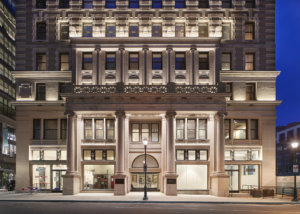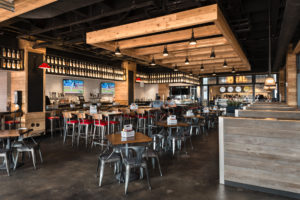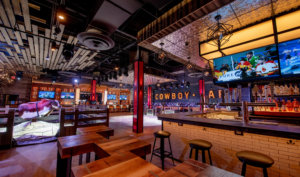Caitlin Bucari, Senior Lighting Designer at The Lighting Practice, shares her experience in hospitality lighting design and discusses trends, common pitfalls, and lessons learned. Caitlin joined The Lighting Practice in 2015 and has worked on a wide range of project types, including hospitality, corporate, mixed-use, retail, and multifamily residential. Her work has earned multiple awards, such as the LIT Design Award in the Ambient Lighting Category, AIA New York Hudson Valley Chapter’s “High Honors Design Award for Recognition of Architectural Excellence,” and Shop! Environments Association’s “Gold Award” and “Store of the Year.”
Caitlin, how did you become a lighting designer?
My path to become a lighting designer happened organically out of college. I have a degree in interior design from Drexel University. My lighting design professor was at our senior show and asked if I would be interested in working at a lighting design firm. At the time, I didn’t realize what a niche it was in the industry. Years later, here I am. I think I have stayed so long because of all the various projects you can have a hand in.
What excites you about designing lighting for hospitality spaces?
I get excited about hospitality because it’s an opportunity to work with a space that’s more dramatic than everyday spaces. Hospitality venues are naturally built for fun and entertainment, so you can take bigger risks, be a lot bolder and explore trends. I get to be more daring with hospitality lighting design.
Are there any key considerations when it comes to hospitality lighting?
Layers, layers, layers. A layered lighting design helps bring focus to the important aspects of a space and creates ambience and drama. Layers really highlight the architecture in the space and reinforce the three-dimensional nature of a building.
What are some trends you’re seeing right now in hospitality lighting?
I’ve been seeing a lot of metallic finishes, both in lighting and other aspects of interior design. Exposed lamps and decorative lighting are very popular in hospitality. We’re also integrating more lighting into the millwork and architecture of a space, such as shelving, a bar, or a staircase.
Another trend is outdoor hospitality spaces, whether as an extension of the building’s interior or as a unique gathering spot. Often, we’re using light to transform an unoccupiable space and make it usable. Restaurants, especially at the moment, need more outdoor areas for people to gather, so they’re recognizing the value of having a dedicated outdoor space that reflects their brand and identity.
How has technology impacted hospitality lighting design?
Everything has been converted to LED at this point, but not all LED fixtures have the dimming capabilities appropriate for a hospitality environment. I’ve had to pay special attention to identify which manufacturers and products work well. It’s important to make sure there’s room in the project budget for dimmable, adjustable lighting. A 1% or a 0.1% dimming driver may cost a little more, but it’s absolutely worth it to create the right moody atmosphere. You might not think you’d notice it, but you do.
What are some other common challenges in hospitality lighting?
It can be a challenge to reconcile a client’s budget with their expectations. In order to create the ideal end result, especially in a hospitality setting, we often use different sources of lighting to create layers – which, in turn, needs be reflected in the budget. The client needs to trust the value that lighting can bring.
Tell us about the Canopy Hotel by Hilton Philadelphia Center City – what did you enjoy about this project?
My favorite aspect of the Canopy Hotel was that it was in a historic building [the Stephen Girard Building, built in 1896]. We had the opportunity to design a beautiful lighting scheme for the façade, which is intact in its original form. On the interior, we helped develop the FFE [furniture, fixtures and equipment] package to complement the cool mix of funky, modern, and art deco interiors with historical elements. The project also featured lots of rich colors and metallics. Our goal was to use interesting fixtures to create a “sparkle” effect, without making it look like a movie set. The end result felt fancy and also a lot of fun.
The Waterside District is another striking hospitality project – what made this project interesting?
We’ve worked with this owner at both the Waterside District as well as Live! Casino Pittsburgh, so we’ve developed a good rhythm and understanding of their goals. The Waterside District is a venue featuring several tenants and lots of different types of spaces. We wanted to establish a cohesive lighting theme, while also creating individualized aesthetics for each tenant. We developed a lighting toolkit that we were able to use across the entire project, with tweaks here and there to make each space feel unique. By varying the finishes and placements of the lights, we could make each space feel special – whether it be a beach shack, beer hall, or cowboy bar – while also offering a streamlined solution that was easy for the owner to operate.
Tell us more about Live! Casino Pittsburgh.
There were some similarities to the Waterside District, and we had developed a good understanding of the owner’s goals. What made Live! Casino Pittsburgh unique was the 24-hour aspect of the venue. Controls were a much higher priority in a continuously operating space, so we had to focus a lot on that aspect.
What do you wish your clients understood about lighting design?
Having clients, especially end users, that understand the value that we bring. When they know that lighting is such an integral part of the experience of a space, and is a key piece to setting the right atmosphere, our job instantly becomes easier. When the end user gets more engaged in the lighting design you become a stronger team, with everyone rooting for the success of a project.
What would be your dream project?
I’ve been lucky to have worked on all sorts of projects – bridges, facades, hospitality – so and I’ve had a lot of great experiences. I enjoy the variety, but I suppose I’d love to work with some really big-name companies and high visibility projects. Working with a notable client or company is an exciting opportunity to come up with new creative ways to interpret and enforce their brand.
What are your predictions for the future of hospitality lighting design?
As we all know, trends naturally come and go. For a while, we’ve been doing a lot of industrial style lighting, with raw materials and exposed bulbs. The next wave might be a little more polished in appearance with more sophisticated forms and finishes.






